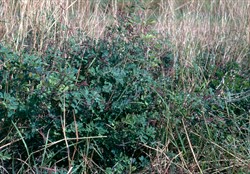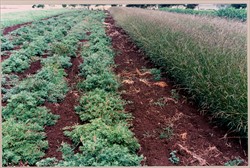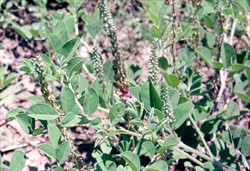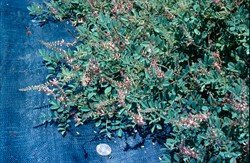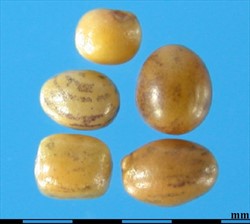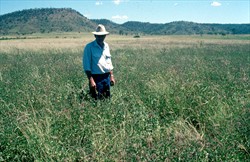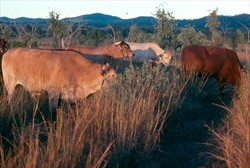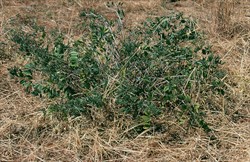Indigofera schimperi
Tropical Forages
Indigofera schimperi Jaub. & Spach
Subordinate taxa:
Indigofera schimperi Jaub. & Spach var. baukeana (Vatke) J.B. Gillett
Indigofera schimperi Jaub. & Spach var. schimperi
Indigofera schimperi Jaub. & Spach: Indigofera tettensis Klotzsch
var. baukeana: Basionym: Indigofera baukeana Vatke
Family: Fabaceae (alt. Leguminosae) subfamily: Faboideae tribe: Indigofereae subsection: Alternifoliolae.
Suffruticose perennial, decumbent, ascending or erect, 0.3–1.3 m tall, suckering from the roots during periods of good moisture. Silvery indumentum on young stem, leaf rachis and inflorescence peduncle and axis. Leaves pinnate, comprising 5–10 leaflets inserted alternately along the rachis; stipules linear-lanceolate, to 9 mm long, with dry membranous margins and fine, tapering tips; rachis sub-cylindrical, channelled above, to ±6 cm long, including a petiole of ±3 mm, prolonged up to 5 mm beyond lateral leaflets; leaflets lanceolate-elliptic or obovate, apiculate, 1–4 cm long and 2 cm wide, with fine appressed hairs on both surfaces (strigulose). Inflorescence a many-flowered raceme 5–20 (–30) cm long including a peduncle of 1–2 cm; bracts reddish, ovate, subulate, ±1 mm long, caducous; pedicels to 1 mm long, reflexed after flowering; calyx white strigulose, 2–3 mm long; lobes triangular, 1–2 times as long as the tube; corolla very pale to deep pink or purplish, densely glistening yellow strigulose outside; standard greenish to yellowish with pink stripes; stamens 4–10 mm long. Pods silky when young, straight, somewhat curved or bent sharply at the base, sub-tetragonal, 18–36 mm long and ±2 mm wide, rather densely white strigulose, up to 12-seeded; endocarp not spotted. 300,000–400,000 (–600,000) seeds/kg.
var. baukeana: plants erect, 0.4–1.3 m tall. Larger flowers (stamens 7–10 mm long), pods usually bent sharply at the base so that they stand away from the stem. Intermediates showing one but not both of these characters occur.
var. schimperi: plants decumbent or ascending to 0.3 m (rarely erect to 1 m tall). Smaller flowers (stamens 4–7 mm long).
Africa: hanuhanis (Kenya); kapiyebiye (Malawi); dharjo, dharqo, geed-guduuka (Somalia)
English: Schimper's indigo
var. baukeana
Native:
Africa: Kenya; Tanzania; Zimbabwe; Namibia
var. schimperi
Native:
Africa: Angola; Botswana; Djibouti; Eritrea; Ethiopia; Kenya; Malawi; Mozambique; Namibia; Somalia; South Africa (Transvaal); Sudan; Swaziland; Tanzania; Uganda; Zambia; Zimbabwe
Asia: Saudi Arabia; Yemen
Forage
Legume for long-term pastures and leys in sub-humid to semi-arid environments.
Environment
No record found.
Other
Somali folk medicine; root mixed with salt to treat temporary impotence.
Soil requirements
Largely found on neutral to alkaline black, cracking clays. Not adapted to acid soils. Moderate salt tolerance, less than that of Macroptilium atropurpureum, M. lathyroides and Desmanthus bicornutus and similar to that of Stylosanthes scabra.
Moisture
Occurs in areas with annual rainfall of 250–1,100 mm, with uni- and bi-modal distribution, and dry season to 8 months. Extremely drought tolerant, but also tolerant of temporary waterlogging and short term flooding. Var. schimperi more tolerant of impeded drainage than var. baukeana.
Temperature
Natural distribution extends from about 18º N in the Sudan to 26º S in South Africa. It occurs from near sea level to 2,100 m asl, with different ecotypes extending over a range of environments with average annual temperature ranging from 17 to 26 ºC.
Light
Largely found in open grassland, but also in grassy areas in mopane (Colophospermum mopane) and mixed Acacia woodland, suggesting a preference for full light, but a tolerance of light shade.
Reproductive development
Flowers March-April in the southern hemisphere subtropics, and again in spring after frost. Indigofera spicata, another member of section Alternifoliae, is cleistogamous. I. schimperi appears to behave similarly, judging by the uniformity of plants within an accession.
Defoliation
Regrows rapidly after cutting and grazing.
Fire
No information available.
Guidelines for establishment and management of sown forages.
Establishment
Establishment is variable especially on clay soils. The seed size is small and it flows freely and falls into the surface mulch. Emergence from seed sown deeper than 2–3 cm is poor and is generally slower than for other legumes such as Desmanthus. Emerged seedlings have a high rate of survival.
Fertilizer
I. schimperi is largely found on "black cotton soils", from which it might be inferred that it requires at least moderate fertility.
Compatibility (with other species)
I. schimperi competes poorly as a seedling with a range of introduced and native grasses, but once established has a high survival rate and a long plant life. Seedling recruitment often takes 2–3 years but is then adequate to maintain and increase plant densities. It has a strong lateral root system and survives and regrows under severe moisture stress. It is relatively unpalatable and for this reason can dominate pastures if grazing is not controlled.
Companion species
Grasses: Bothriochloa spp., Chloris gayana, Cenchrus ciliaris, Dichanthium spp.
Legumes: Clitoria ternatea, Desmanthus spp., Stylosanthes seabrana
Pests and diseases
While there is no record of serious fungal or insect damage, seed beetles (Bruchidius malindiensis and B. subdolus, Coleoptera: Chrysomelidae: Bruchinae) have been recorded in seed in native populations in Kenya.
Ability to spread
Although it has no apparent characteristics that will aid spread it is a highly persistent and productive legume and sets seed even under severe moisture stress. Also it has this ability to sucker from its extensive lateral root system.
Weed potential
It has significant weed potential mainly because of its high survival and largely low palatability to grazing livestock. Commercialisation has been withdrawn in Queensland, Australia, and control measures in experimental sowings have been undertaken.
Nutritive value
Crude protein content can vary from <10% in the stem to >20% in the leaf. ADF ranged from 28% (leaf) to 36% (stem).
Palatability/acceptability
Poor palatability but is eaten under some conditions. There are some differences in palatability between accessions with CPI 73608 and CPI 16055 sometimes being grazed more readily than the other accessions.
Toxicity
I. schimperi contains no indospicine and no other toxicities are known.
Dry matter
In experimental plots, annual yields of up to 4,500 kg/ha have been measured although growth is sometimes slow in the establishment year.
Animal production
I. schimperi displayed good chemical composition and no problems in feeding trials with rats, but was poorly accepted in grazing trials with cattle and supported poor weight gains.
Steer liveweight-gains over 2 grazing periods at Gayndah in Queensland, Australia, ranged from 0.27 to 0.38 kg/head/day compared with 0.41–0.56 kg/head/day for other legumes.
2n=16.
No information available.
Susceptible to a range of broadleaf herbicides including metsulphuron-methyl and fluroxypyr although results can be variable.
- Adapted to semi-arid environments.
- Adapted to clay soils.
- Moderate salt tolerance.
- Persistent and productive.
- Poor palatability.
- Animal growth rates inferior to other legumes such as Desmanthus and Stylosanthes.
- Difficult to manage grazing to reduce legume dominance.
Clem, R.L. and Hall, T.J. (1994) Persistence and productivity of tropical pasture legumes on three cracking soils (Vertisols) in north-eastern Queensland. Australian Journal of Experimental Agriculture 34:161–171. doi.org/10.1071/EA9940161
Clem, R.L., Brandon, N.J., Conway, M.J., Esdale, C.R. and Jones, R.M. (2001) Early stage evaluation of tropical legumes on clay soils at three sites in central and southern inland Queensland. Technical Memorandum No. 7. CSIRO Tropical Agriculture, St Lucia, Australia.
Delobel, A. and Le Ru, B. (2010) New African seed beetles associated with Indigofera (Coleoptera: Chrysomelidae: Bruchinae). Genus (Wrocław) 21:61–81. bit.ly/2QSkETT
Frahm-Leliveld, J.A. (1960) Observations on chromosomes in the genus Indigofera L. Acta Botanica Neerlandica 9:286–293. doi.org/10.1111/j.1438-8677.1960.tb00658.x
Gillett, J.B., Polhill, R.M. and Verdcourt, B. (1971) Leguminosae (Part 3) Subfamily Papilionoideae. In: Milne-Redhead, E. and Polhill, R.M. (eds) Flora of Tropical East Africa. Crown Agents for Overseas Governments and Administrations, London, UK. p. 313–314.
Jones, R.M. and Rees, M.C. (1997) Evaluation of tropical legumes on clay soils at four sites in southern inland Queensland. Tropical Grasslands 31:95–106. bit.ly/2JoUtQC
Jones, R.M. (1998) Evaluation of a range of tropical legumes on two clay soils in south east inland Queensland. Technical Memorandum No. 2. CSIRO Tropical Agriculture, St Lucia, Australia.
Jones, R.M., Bishop, H.G., Clem, R.L., Conway, M.J., Cook, B.G., Moore, K. and Pengelly, B.C. (2000) Measurements of nutritive value of a range of tropical legumes and their use in legume evaluation. Tropical Grasslands 34:78–90. bit.ly/2WMzAqx
Jones, R.M., Brandon, N.J. and Conway, M.J. (1996) Indigofera schimperi - a promising legume for permanent pastures on clay soils. Tropical Grasslands 30:138.
Strickland, R.W, Lambourne, L.J. and Ratcliffe, D. (1986) The palatability, feeding value and apparent toxicity of 150 legume species fed to rats. Genetic Resources Communication No. 10. CSIRO Tropical Agriculture, St Lucia, Australia. bit.ly/33YYCUX
None released.
Tested as a pasture legume on clay soils in central Queensland, Australia but withdrawn from commercialisation because of generally poor acceptance by grazing stock and the high risk of legume dominance.
CPI 16055 Selected in Australia. Origin Kabete, Kenya (1º14' S, 1,800 m asl, rainfall 900mm). Lower growing type that was more readily grazed than the other I. schimperi.
CPI 73608 Selected in Australia. Origin Pokot, Kenya. Tall open type grazed in preference to CPI 52621 and CPI 69495.
CPI 52621 Selected in Australia. Origin Matopos, Zimbabwe (20º23' S, 1,340 m asl, rainfall 600 mm). Selected for performance on vertisols in sub-humid subtropics.
CPI 69495 Selected in Australia. Origin Bulawayo, Zimbabwe (19º44' S, 1,150 m asl, rainfall 600 mm). Selected for performance on vertisols in sub-humid subtropics.
